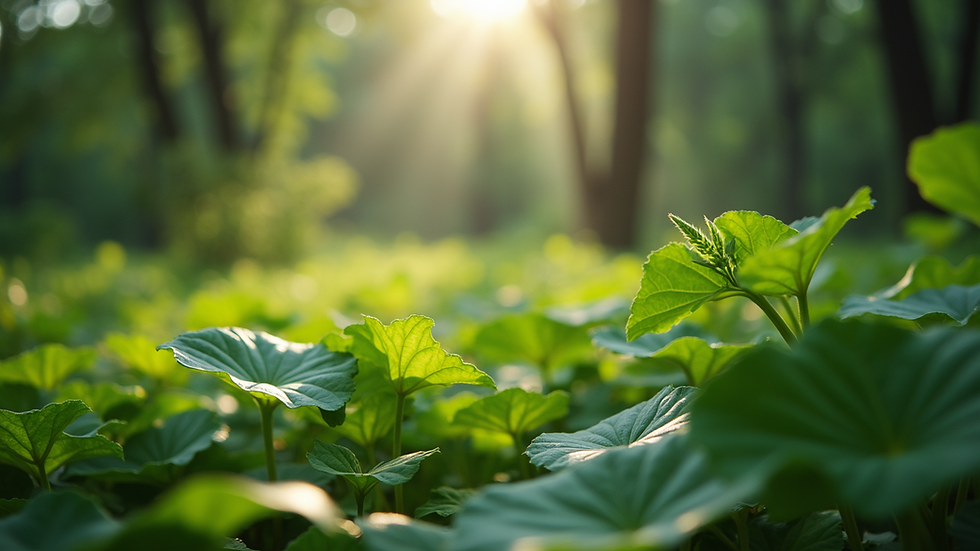Essential Tips for Creating a Thriving Shade Garden
- Alla P.
- May 23
- 4 min read
Creating a thriving shade garden can seem like a daunting task. Many gardeners often overlook the potential beauty that shade can offer. However, with the right plants, design, and care, you can transform your shaded areas into vibrant and lush retreats. This guide will provide essential tips for cultivating a beautiful shade garden that will thrive for years to come.
Understanding Your Shade Garden
Before diving into the specifics of planting, it is essential to understand the type of shade your garden has. Shade can be classified into three primary categories:
Full Shade: Areas that receive less than 3 hours of direct sunlight per day.
Partial Shade: Areas that receive 3 to 6 hours of sunlight, often depending on the time of day or season.
Dappled Shade: Areas that receive filtered sunlight, often through trees or structures that allow some light while blocking direct rays.
Recognizing these differences can help you choose the right plants for your shade garden. For instance, full-shade plants will wilt in areas that receive direct sunlight, while some plants may thrive in dappled shade but struggle in full shade.

Choosing the Right Plants for Shade
Selecting suitable plants is crucial for a successful shade garden. Some common plants that thrive in low-light conditions include:
Hostas: Known for their lush foliage, hostas come in various sizes and colors. They are resilient and can adapt well to different soil conditions.
Ferns: These hardy plants bring a delicate texture to the garden. There are many types of ferns, so choose those that best fit your area’s moisture levels.
Astilbe: Producing beautiful feathery flowers, Astilbe can add a splash of color to the shade.
Additionally, consider incorporating Coleus into your garden. Their bright colors and varied leaf shapes can provide an eye-catching focal point. For more tips on growing these stunning plants, check out coleus gardening.
When planning your plant selections, think about their bloom times and how they complement each other throughout the seasons. Layering plants of varying heights and textures will create an engaging visual landscape.

Do Coleus Do Better in Pots or in the Ground?
When it comes to planting coleus, both pots and the ground offer unique benefits, depending largely on your garden's needs and your local climate.
Pots: Planting coleus in pots allows for mobility. You can relocate the pots to optimal light conditions or indoors during extreme weather. This mobility is especially useful if your area experiences drastic seasonal changes.
Ground: Planting in the ground can lead to larger, more robust plants as they have access to more nutrients. Additionally, ground-planted coleus can create a lush carpet of color when planted en masse.
Assess your gardening goals and the environment you’re working with to determine which option is best for you.
Designing Your Shade Garden
Designing a shade garden offers a fantastic opportunity to express your creativity. Here are some tips for planning a stunning layout:
Layering: Use taller plants in the back and shorter ones in the front. This not only provides visual interest but also maximizes the usage of space.
Pathways: Incorporate paths using gravel, stepping stones, or mulch. This can create a sense of flow and allow for easy access.
Seating Areas: If space permits, include a small sitting area. This can provide a lovely retreat where you can enjoy your serene environment.
Color Palette: Opt for a color scheme that harmonizes well. Consider combining bright foliage plants with those that have subtle shades for balance.
By designing with intention, you will create not only a functional space but also a stunning visual display.

Maintenance Tips for Your Shade Garden
To keep your shade garden thriving, regular maintenance is key. Here are some practical tips:
Watering: Shade gardens may retain moisture longer, but it's essential to monitor the soil. Use mulch to retain moisture and reduce weeds, but ensure it doesn’t smother the roots of your plants.
Pruning: Regularly prune your plants to promote healthy growth. This helps prevent overcrowding and encourages air circulation.
Fertilization: Use organic fertilizers to enrich the soil. Most shade plants thrive in well-drained, nutrient-rich soil.
Pest Control: Keep an eye out for pests that might invade your garden. Natural predators like ladybugs can help keep aphid populations in check.
By following these maintenance tips, your shade garden will remain vibrant and healthy.
Enjoying Your Shade Garden
Creating a thriving shade garden is not just about planting; it's about enjoying the space you've cultivated. Spend time in your garden, observing the plants as they grow and change with the seasons. You might even want to consider:
Photography: Capture the evolution of your garden through various seasons.
Gardening Journals: Keeping a journal can help document what works best for your shade garden and keep track of what you want to try next.
Sharing with Friends: Share your garden with friends and family, or even create social media posts to inspire others to embrace the beauty of shade gardening.
A shade garden should be a space of tranquility and beauty, one that you can enjoy year after year.
By following these essential tips, you can ensure that your shade garden is not only thriving but also a beautiful haven that enhances your outdoor space. Whether you are new to gardening or an experienced green thumb, your shade garden holds limitless potential. Embrace it, nurture it, and let it flourish!























Comments